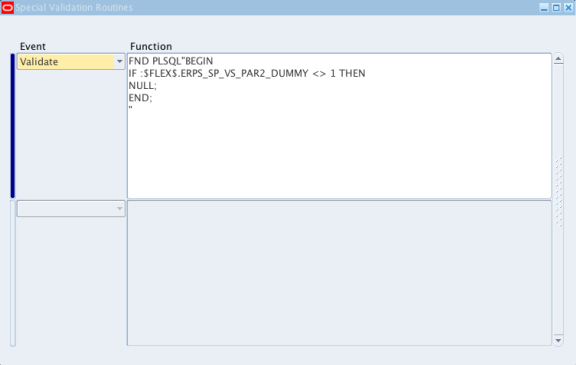Dependent Parameters in Oracle Applications
Requirement:
Say there is a concurrent program that lets you retrieve employee details based on employee name or employee number.
The concurrent program has 3 parameters:
1.Search Criteria is a value set containing “Employee Name” and “Employee Number” as values
2.Employee Name
3.Employee Number
When the user wants to search employee based on Employee number, he selects Employee Number in the parameter “Search Criteria”.
Automatically Employee name parameter should be disabled so that user can enter only number in the parameter Employee number to search that employee.
Similarly if the users wants to to search employee based on Employee name, Employee number parameter should be disabled thus preventing the users to search based on Employee number.

As seen in the above screenshot, say there is a Concurrent program which has 3 parameters defined:
1. Select Parameter to Disable
2. Parameter – 1
3. Parameter – 2
And Parameter “Select Parameter to Disable” is a value set that has values –
PARAM-1, PARAM-2
The requirement here is if the user selects PARAM-1 as the value for the parameter “Select Parameter to Disable”, then the Parameter “Parameter – 1” should be disabled meaning the user should not be able to enter any information for that parameter.
If user selects PARAM-2 as the value for the parameter “Select Parameter to Disable”, then the Parameter “Parameter – 2” should be disabled.
Steps to implement the above requirement:
1. Create the below Value Sets:
I. Value Set “ERPS_SP_VS_PARA_DEMO”:
· Navigation: System Administrator responsibility>Application>Validation>Set
· Enter the details as shown in screenshot below and save your work.

· Navigation: System Administrator responsibility>Application>Validation>Values
· Give the name as “ERPS_SP_VS_PARA_DEMO” and click on Find.

· Enter Values as PARAM-1 and PARAM-2 as shown bin the below screenshot and save your work.

II. Value Set “ERPS_SP_VS_PAR1_DUMMY”:
· Navigation: System Administrator responsibility>Application>Validation>Set
· Enter the details as shown in screenshot below and save your work.

III. Value Set ERPS_SP_VS_PAR2_DUMMY
· Navigation: System Administrator responsibility>Application>Validation>Set
· Enter the details as shown in screenshot below

IV. Create Value Set ERPS_SP_VS_PAR1
· Navigation: System Administrator responsibility>Application>Validation>Set
· Enter the details as shown in screenshot below.
· Click “Edit Information” button.

· Select Event as Validate and add the below code in the Function textbox
FND PLSQL”BEGIN
IF :$FLEX$.ERPS_SP_VS_PAR1_DUMMY <> 1 THEN
NULL;
END IF;
END;
”
· Save your work

V. Create Value Set ERPS_SP_VS_PAR2
· Navigation: System Administrator responsibility>Application>Validation>Set
· Enter the details as shown in screenshot below.
· Click “Edit Information” button.

· Select Event as Validate and add the below code in the Function textbox
FND PLSQL”BEGIN
IF :$FLEX$.ERPS_SP_VS_PAR2_DUMMY <> 1 THEN
NULL;
END;
”

· Save your work
2. Define Executable for the concurrent program
· Navigation: System Administrator responsibility>Concurrent>Program>Executable
· Enter the details as shown in screenshot below.
· Save your work

3. Define the concurrent program:
· Navigation: System Administrator responsibility>Concurrent>Program>Define
· Enter the details as shown in screenshot below.
· Save your work

4. Define Parameters for the concurrent program:
· Click on “Parameters” button and enter the below details
A. Seq: 10
B. Parameter: Enter Parameter Num to Disable
C. Value Set: ERPS_SP_VS_PARA_DEMO
D. Prompt: Select Parameter to Disable

A. Seq:15
B. Parameter: Parameter – 1 Dummy
C. Value Set: ERPS_SP_VS_PAR1_DUMMY
D. Default Type: SQL Statement
E. Default Value: select 1 from Dual where :$FLEX$.ERPS_SP_VS_PARA_DEMO != ‘PARAM-1’
F. Uncheck the Display Checkbox

A. Seq:20
B. Parameter: Parameter – 1
C. Value Set: ERPS_SP_VS_PAR1

A. Seq:25
B. Parameter: Parameter – 2 Dummy
C. Value Set: ERPS_SP_VS_PAR2_DUMMY
D. Default Type: SQL Statement
E. Default Value: select 1 from Dual where :$FLEX$.ERPS_SP_VS_PARA_DEMO != ‘PARAM-2’
F. Uncheck the Display Checkbox

A. Seq:30
B. Parameter: Parameter – 2
C. Value Set: ERPS_SP_VS_PAR2
D. Save the work.

Assign this concurrent program to the desired responsibility and check the result.
For detailed explanation on how to define a concurrent program, please refer to the below article:
http://erpschools.com/articles/concurrent-program-registration-and-add-it-to-request-group